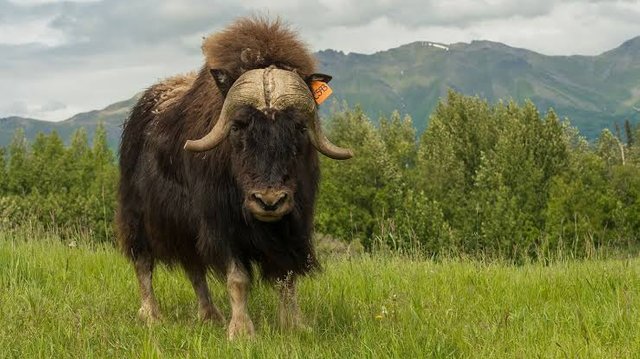Musk Ox
English
Introduction
This wild bull, with its thick brown and black fur and a plate of horns spread over its forehead, lives in extremely cold regions. Its fur hair is so long and thick that it can hang down to the ground.
Scientific name:
Ovibos moschatus
Geographical boundaries:
Alaska (USA)
Russia
Greenland
Accommodation:
Tundra Tundra
Physical measurements:
Height = up to 5 feet.
Length = up to 8 feet.
Weight = 180 to 410 kg.
Age:
Up to 20 years
Food:
Grass and plants.
way of life:
Musk bull is a social animal that lives in herds of 12 to 24.
It inhabits the coldest regions of the world and can withstand temperatures of up to 40 degrees Celsius.
Each herd has a head bull. Male musk bulls fight among themselves for the head of the herd and the territory. The method is that they run at a distance of twenty meters towards each other and hit each other on the head. The plates of his forehead horns prevent his head from being broken and his brain from being damaged during such a collision. Musk bulls are also strict on musk cows and prevent them from moving to other herds. Difficult bulls claim their right to lead by kicking their cows.
In the natural environment, musk bulls are at risk of being hunted by bears and wolves.
This is done in a special way to prevent this danger. Musk bulls put their cows and calves in the middle and stand in a circle around them so that each musk bull faces out of the circle. This circle is often made during the calving period whenever danger is felt.
It is a fast moving animal that can run at a speed of 60 kilometers per hour.
Breeding:
Musk bull is a polygamous animal.
They have a breeding season in June-July. The gestation period is 9 months. Musk cow gives birth to 1 calf per season. Calves are raised under the care of their parents for 2 years after birth.
Musk bulls mature and breed at 3 to 4 years of age.
Survival status:
Musk bulls have long been hunted for meat and fur, which has significantly reduced its population, but now it is stable due to safety measures and surveillance.
Spanish
Buey almizclero:
Este toro salvaje, con su espeso pelaje marrón y negro y una extensión de cuernos en la frente, vive en regiones extremadamente frías. Su pelaje es tan largo y grueso que puede colgar hasta el suelo.
۔Nombre científico:
Ovibos moschatus
Límites geográficos:
Alaska (Estados Unidos)
Rusia
Groenlandia
۔Alojamiento:
Tundra Tundra
۔Medidas físicas:
Altura = hasta 5 pies.
Longitud = hasta 8 pies.
Peso = 180 a 410 kg.
۔Edad:
Hasta 20 años
۔Comida:
Hierba y plantas.
۔estilo de vida:
El toro almizclero es un animal social que vive en manadas de 12 a 24.
Habita en las regiones más frías del mundo y puede soportar temperaturas de hasta 40 grados centígrados.
Cada manada tiene un toro cabeza. Los toros almizcleros machos luchan entre ellos por la cabeza de la manada y el territorio. El método es que corren a una distancia de veinte metros uno hacia el otro y se golpean en la cabeza. Las placas de los cuernos de su frente evitan que su cabeza se rompa y su cerebro se dañe durante tal colisión. Los toros almizcleros también son estrictos con las vacas almizcleras y evitan que se trasladen a otros rebaños. Los toros difíciles reclaman su derecho a liderar pateando a sus vacas.
En el entorno natural, los toros almizcleros corren el riesgo de ser cazados por osos y lobos.
Esto se hace de una manera especial para prevenir este peligro.Los toros almizcleros colocan a sus vacas y terneros en el medio y se colocan en un círculo alrededor de ellos para que cada toro almizclero mire hacia afuera del círculo.Este círculo a menudo se hace durante el período de parto siempre que se siente el peligro.
Es un animal de rápido movimiento que puede correr a una velocidad de 60 kilómetros por hora.
۔Cría:
El toro almizclero es un animal polígamo.
Tienen una temporada de reproducción en junio-julio. El período de gestación es de 9 meses. La vaca almizclera da a luz a 1 ternero por temporada. Los terneros se crían bajo el cuidado de sus padres durante 2 años después del nacimiento.
Los toros almizcleros maduran y se reproducen entre los 3 y 4 años de edad.
۔Estado de supervivencia:
Los toros almizcleros han sido cazados durante mucho tiempo por su carne y piel, lo que ha reducido significativamente su población, pero ahora es estable debido a las medidas de seguridad y vigilancia.
Thanks to beloved:
@fendit
@belenguerra
